Related Research Articles
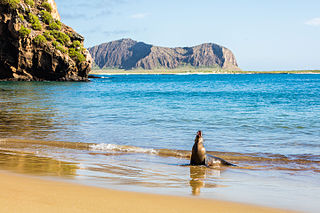
The Galápagos Islands are an archipelago of volcanic islands in the Eastern Pacific, located around the Equator 900 km (560 mi) west of the mainland of South America. They form the Galápagos Province of the Republic of Ecuador, with a population of slightly over 33,000 (2020). The province is divided into the cantons of San Cristóbal, Santa Cruz, and Isabela, the three most populated islands in the chain. The Galápagos are famous for their large number of endemic species, which were studied by Charles Darwin in the 1830s and inspired his theory of evolution by means of natural selection. All of these islands are protected as part of Ecuador's Galápagos National Park and Marine Reserve.
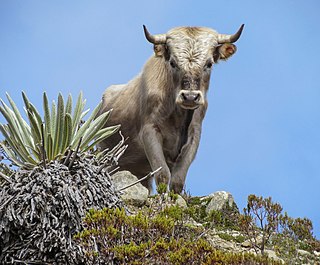
A feral animal or plant is one that lives in the wild but is descended from domesticated individuals. As with an introduced species, the introduction of feral animals or plants to non-native regions may disrupt ecosystems and has, in some cases, contributed to extinction of indigenous species. The removal of feral species is a major focus of island restoration.

The Channel Islands are an eight-island archipelago located within the Southern California Bight in the Pacific Ocean, off the coast of California. They define the Santa Barbara Channel between the islands and the California mainland. The four Northern Channel Islands are part of the Transverse Ranges geologic province, and the four Southern Channel Islands are part of the Peninsular Ranges province. Five of the islands are within the Channel Islands National Park. The waters surrounding these islands make up Channel Islands National Marine Sanctuary. The Nature Conservancy was instrumental in establishing the Channel Islands National Marine Sanctuary.

The island fox is a small fox species that is endemic to six of the eight Channel Islands of California. There are six subspecies, each unique to the island it lives on, reflecting its evolutionary history. They are generally docile, show little fear of humans, and are easily tamed. Island foxes played an important role in the spiritual lives of native Channel Islanders. They have been likely semi-domesticated as pets, used as pelts, or for other functions, like pest control.
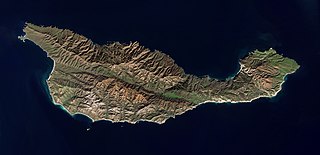
Santa Cruz Island is located off the southwestern coast of Ventura, California, United States. It is the largest island in California and largest of the eight islands in the Channel Islands archipelago and Channel Islands National Park. Forming part of the northern group of the Channel Islands, Santa Cruz is 22 miles (35 km) long and 2 to 6 miles wide with an area of 61,764.6 acres (249.952 km2).

Colonial Spanish horse is a term for a group of horse breed and feral populations descended from the original Iberian horse stock brought from Spain to the Americas. The ancestral type from which these horses descend was a product of the horse populations that blended between the Iberian horse and the North African Barb. The term encompasses many strains or breeds now found primarily in North America. The status of the Colonial Spanish horse is considered threatened overall with seven individual strains specifically identified. The horses are registered by several entities.

The island scrub jay, also known as the island jay or Santa Cruz jay, is a bird in the genus, Aphelocoma, which is endemic to Santa Cruz Island off the coast of Southern California. Of the over 500 breeding bird species in the continental U.S. and Canada, it is the only insular endemic landbird species.

The island spotted skunk is an insular endemic carnivore and a subspecies of the western spotted skunk. Little is known about their exact variations from the mainland spotted skunk and variations between locations, resolution of which awaits further genetic and morphologic evaluation. The skunk is only currently found on two islands off the southern coast of California. Its presence has been recorded on San Miguel Island, but it has since been declared extinct in that area. The Channel Island skunk is one of two terrestrial carnivores on the islands, the other being the island fox. It is designated as a species of special concern by the state of California.
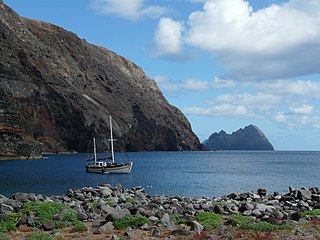
The Desertas Islands are a small archipelago in the Atlantic Ocean, part of the larger Portuguese Madeira Archipelago.
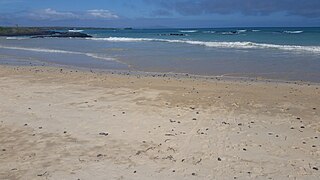
Santa Fe Island, also known as Barrington Island, is a small island of 24 square kilometres (9.3 sq mi) which lies in the middle of the Galápagos Archipelago in Ecuador. Visitor access is by a wet landing in Barrington Bay on the northeastern side of the island.

A feral horse is a free-roaming horse of domesticated stock. As such, a feral horse is not a wild animal in the sense of an animal without domesticated ancestors. However, some populations of feral horses are managed as wildlife, and these horses often are popularly called "wild" horses. Feral horses are descended from domestic horses that strayed, escaped, or were deliberately released into the wild and remained to survive and reproduce there. Away from humans, over time, these animals' patterns of behavior revert to behavior more closely resembling that of wild horses. Some horses that live in a feral state but may be occasionally handled or managed by humans, particularly if privately owned, are referred to as "semi-feral".
The Santa Cruz mouse is a species of rodent in the family Cricetidae. It is endemic to Mexico, where it is found only on two small islands in the southern Gulf of California. Feral cats on Santa Cruz Island are a threat.
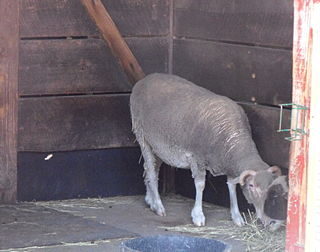
Santa Cruz sheep are an extremely rare breed of domestic sheep that once existed as a feral population on the Santa Cruz Island of the Channel Islands of California. Small and hardy, the sheep were all killed or removed from the island to prevent destruction of natural habitats. Today, they number fewer than 200 animals. This breed is primarily raised for wool.
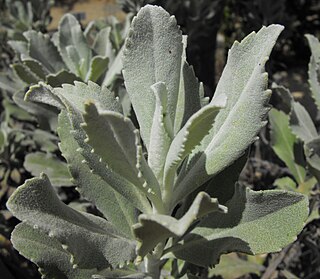
Hazardia detonsa is a rare species of shrub in the family Asteraceae known by the common name island bristleweed. It is endemic to the Channel Islands of California, having been found on 4 islands.

Crocanthemum greenei is a rare species of flowering plant in the rock-rose family known by the common name island rush-rose. It is endemic to the Channel Islands of California, where it grows in the chaparral of the rocky seaside slopes. It is present on three of the eight islands, where it has historically been threatened by feral herbivores such as the Santa Cruz sheep and is making a gradual recovery. It is a federally listed threatened species.
Malacothrix indecora is a rare species of flowering plant in the family Asteraceae known by the common name Santa Cruz Island desertdandelion. It is endemic to the Channel Islands of California, where it is known from only a few populations on three of the eight islands. As of 2000, there were three occurrences on San Miguel Island, two on Santa Rosa Island, and one on Santa Cruz Island. It grows on the bluffs and rocky coastal grasslands of the islands. Like many Channel Islands endemics, this plant is naturally limited in distribution and has been threatened by the presence of destructive introduced mammals, in this case, feral pigs. The plant became a federally listed endangered species in 1997. This is a mat-forming annual herb which spreads low to the ground no more than about 10 centimeters high. The fleshy leaves have dull lobes. The inflorescence is an array of flower heads lined with oval-shaped phyllaries. The ray florets are under a centimeter long and yellow in color.

Sibara filifolia, the Santa Cruz Island winged rockcress or Santa Cruz Island rockcress, is a rare species of flowering plant in the family Brassicaceae. It is endemic to the Channel Islands of California, where it is now known from a few occurrences on San Clemente Island and one population on Catalina Island.

Thysanocarpus conchuliferus is a rare species of flowering plant in the mustard family known by the common name Santa Cruz Island fringepod. It is endemic to Santa Cruz Island, one of the Channel Islands of California, where has been recently observed at only one location; some years it is totally absent.

When the Killing's Done is a 2011 novel by T. C. Boyle. The book is an environmental and family drama revolving around the Channel Islands of California—specifically Anacapa and Santa Cruz—and the controversy surrounding efforts by the National Park Service and its partners to eradicate invasive species and revitalize the islands' natural communities.

The Cumberland Island horses are a band of feral horses living on Cumberland Island in the state of Georgia. Popular myth holds that horses arrived on the island sometime in the 16th century with the arrival of the Spanish conquistadors. However, it is unlikely that any horses left by the Spanish survived, and more likely the current population descends from horses brought to the island in the 18th century by the English. Cumberland Island became part of the Cumberland Island National Seashore in 1972 when the National Park Service (NPS) took over its management. These horses are similar to the bands of horses living on the islands of Chincoteague and Assateague. There is estimated to be a population of between 150 and 200 horses on the island. Horses on Cumberland Island have a relatively short life expectancy, due to pest infestations, disease and their rugged environment. In 2000 a behavioral study found that instability marks the bands, with large numbers of co-dominant stallions, early dispersal of juveniles, and frequent band-changing among mares.
References
- ↑ Blumenshine, K.M. (2002). "Preliminary Survey of Physical, Genetic, Physiological and Behavioral Traits of Feral Horses (Equus caballus) on Santa Cruz Island". Santa Barbara Museum of Natural History: 315.
- ↑ "Santa Cruz Island Horse" . Retrieved 2017-06-02.